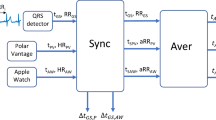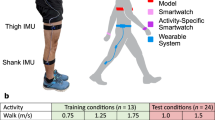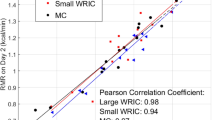Abstract
Objective: Heart rate monitoring has previously been used as a technique for measuring energy expenditure (EE) in field studies. However, the combination of heart rate monitoring with movement sensoring could have theoretical advantages compared to either method used alone. Therefore, this study was undertaken to develop and validate a new combined heart rate monitor and movement sensor instrument (HR+M) for measuring EE.
Methods: The HR+M instrument is a single-piece instrument worn around the chest which records minute-by-minute heart rate and movement. Eight subjects underwent an individual calibration in which EE and heart rate were measured at rest and during a sub-maximal bicycle ergometer test. They then wore the HR+M for 24 hours in a whole-body calorimeter and underwent a standard protocol including periods of physical activity and inactivity. Minute-by-minute heart rate was converted to EE using individual calibration curves with the motion data discriminating between periods of inactivity and activity at low heart rate levels. EE was also calculated using the HRFlex method which relies on heart rate alone. Both estimates of EE were compared to EE measured in the whole-body calorimeter.
Results: The mean percentage error of the HR+M method calculating TEE compared with the gold standard of the calorimeter measurement was 0.00% (95% CI of the mean error −0.25, 1.25). The HRFlex method using the heart rate information alone resulted in a mean percentage error of 16.5% (95% CI of the mean error −0.57, 1.76).
Conclusions: This preliminary test of HR+M demonstrates its ability to estimate EE and the pattern of EE and activity throughout the day. Further validation studies in free-living individuals are necessary.
Sponsorship: NJW is an MRC Clinician Scientist Fellow. KLR holds an MRC PhD scholarship.
European Journal of Clinical Nutrition (2000) 54, 409–414
This is a preview of subscription content, access via your institution
Access options
Subscribe to this journal
Receive 12 print issues and online access
$259.00 per year
only $21.58 per issue
Buy this article
- Purchase on Springer Link
- Instant access to full article PDF
Prices may be subject to local taxes which are calculated during checkout
Similar content being viewed by others
Author information
Authors and Affiliations
Contributions
Guarantor: NJ Wareham
Contributors: NJ Wareham, T Roswell, D Holburn and SA Jebb developed the original idea for the sensor and designed the testing study. T Roswell and D Holburn were responsible for the production of the prototype. NJ Wareham, SA Jebb and K Rennie supervised the fieldwork in the testing study. All authors contributed to the paper.
Corresponding author
Rights and permissions
About this article
Cite this article
Rennie, K., Rowsell, T., Jebb, S. et al. A combined heart rate and movement sensor: proof of concept and preliminary testing study. Eur J Clin Nutr 54, 409–414 (2000). https://doi.org/10.1038/sj.ejcn.1600973
Received:
Revised:
Accepted:
Published:
Issue Date:
DOI: https://doi.org/10.1038/sj.ejcn.1600973
Keywords
This article is cited by
-
A systematic literature review of reviews on techniques for physical activity measurement in adults: a DEDIPAC study
International Journal of Behavioral Nutrition and Physical Activity (2018)
-
Study of the association between gait variability and physical activity
European Review of Aging and Physical Activity (2017)
-
Accuracy of a combined heart rate and motion sensor for assessing energy expenditure in free-living adults during a double-blind crossover caffeine trial using doubly labeled water as the reference method
European Journal of Clinical Nutrition (2015)
-
Different methods for monitoring intensity during water-based aerobic exercises
European Journal of Applied Physiology (2012)
-
Accuracy of the Actiheart for the assessment of energy expenditure in adults
European Journal of Clinical Nutrition (2008)



